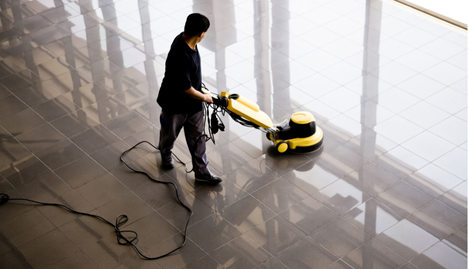How to Polish Marble Floors with a Machine?

Marble is an attractive stone that is natural and generally resilient. However, it is porous and water or other spilled liquids can be absorbed into the surface, resulting in stains, discolouration and a dull appearance.
Acidic substances such as lemon and vinegar can also cause damage, while dirt and abrasive cleaning methods can scratch the surface, allowing dust to accumulate and reduce the stone’s natural shine. However, there are various methods to care for your marble floor and restore its appearance. For all cleaning methods, wear protective gear such as a dust mask or respirator, gloves and safety goggles.
1. Polishing by Hand
This is only really feasible in a small area for infrequent cleaning. Anything more regular and larger requires a machine to make the job practical.
First, remove all dust with a soft mop or cloth to avoid scratching the floor, paying particular attention to corners. You can then quickly clean with a damp or dry mop, avoiding too much water that can soak into the surface. Adding half a cup of ammonia to a gallon of water will add sparkle to the floor. Dry with a damp cloth, apply cornstarch to absorb any grease and finish by polishing with a paste made from equal volumes of baking soda and water.
2. Wet Polish Using a Sanding Machine
This is particularly appropriate for floors that are damaged or very dull. Additionally, it is generally only necessary to do this every few years, whereas manual polishing is a more frequent task.
First, remove any old wax or sealant using a marble-safe commercial stripper that you apply with a soft brush or sponge. Protect anything that borders the floor.
Wet the floor to prevent dust and reduce friction, then sand the floor using a circular motion. Start with 120-grit sandpaper, then change to 300 grit and finish with 600 grit. Between each change of sandpaper, wash away any excess dust and apply more water. Then make a final pass with a sponge to remove the remaining dust.
Clean any remaining particles with a dry mop, sprinkle the commercial polishing powder on the floor and then buff with a circular motion, using a microfibre polishing pad attached to the sander. With a dry mop, remove any remaining dust and then, for extra protection against scuffs and stains, apply marble sealant.
3. Dry Polish Using an Orbital Sander
As for a wet polish, first thoroughly clean the marble. Then, ideally, use an orbital sander since this moves automatically and reduces the chances of damage, although any sanding tool will do the job.
Use either silicone-carbide sandpaper or diamond polishing pads. For the former, start with 60 grit and then progress through 120, 220, 320 and finish with 1,000 grit. For the latter, start with 50 grit and work up to a very fine 3,000 grit. Between each cycle, use a dry or damp soft cloth to remove dust and debris, also using a vacuum with a soft brush. As a final stage, seal the marble to protect it from spills and scuffs.
Protecting Your Marble Floor
To prolong the good looks of your marble floor, clean regularly and ensure it’s kept dry to avoid water penetration. Remove stains immediately, seal for added protection and put down mats or rugs in busy areas. We can provide all the equipment and materials you need as well as plenty of advice to preserve the look of your marble, so contact us if you need anything.







